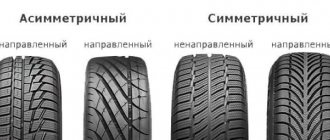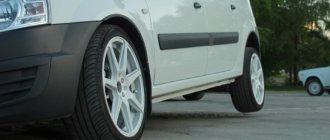The start of sales of the Lada Vesta SV Cross all-terrain station wagon was given about a year ago. The new product of the domestic automobile industry turned out to be quite successful in sales. This is facilitated by a fresh design and good build quality.
In addition to this station wagon, the AvtoVAZ line, as you've probably heard about, includes the Vesta sedan models (regular and cross versions) and the Vesta SV city station wagon. A characteristic difference between the SV Cross station wagon and other models is the installation of large wheels with a diameter of 17 inches.
In this article, we suggest delving into the topic of wheels and answering basic questions about choosing tires for the Lada Vesta SV Cross.
Experienced car owners know that tires are an important component in the operation of the car. The choice of tires affects many parameters, including handling, braking distance, fuel consumption, vehicle acceleration dynamics and road stability.
In addition, well-selected tires reduce driving noise and reduce the wear and tear of your vehicle's suspension. As you can see, the choice of car tires for the Lada Vesta SV Cross, as well as for any other car, must be approached very responsibly.
Typical tire size
So, to better understand the type of tires, let's look at the table that shows the main indicators. After carefully studying the data, the choice of tires for the Vesta SV Cross with the following parameters becomes obvious: 205/50 R17.
In fact, AvtoVAZ recommends using these. Moreover, this type of rubber may have different load capacity and speed indices.
If the owner installs wheels that require a slightly different type of tire, it is permissible to use slightly wider (215) and narrower (195) tires. The table below shows typical options for wheels and tires that can be installed on the Lada Vesta SV Cross.
| Acceptable tire and wheel options | |
| Tires | Discs |
| 195/65 R15 | 6.0Jx15 ET37 |
| 205/55 R16 | 6.0Jx16ET40 |
| 205/50 R17 | 6.5Jx17 ET41 |
| 205/45 R18 | 7.0Jx18 ET38 |
| 215/45 R17 | 7.0Jx17 ET38 |
| 215/40 R18 | 7.0Jx18 ET38 |
From the table we can draw a simple conclusion: if you need higher tires, you need to install wheels of a smaller diameter. So, to install the highest (65) tires, you will need 15-inch wheels.
Video review of tires on Lada Vesta SV Cross:
Decoding tire markings
However, not everyone finds it easy to understand the large number of parameters with which tires are marked.
As a rule, when choosing tires, buyers focus only on the diameter, width of the rubber profile and height, after which the speed and load capacity index are selected.
Now let’s look at what this or that inscription on car tires means. Let's do this using the example of a tire marked 195/65 R15 91 T XL. In this case, the manufacturer and the specific model are not important, we are only interested in the marking itself.
The first number in the marking always indicates the width of the tire in millimeters. The sample in question has a diameter of 195 mm.
The next number is the tire height. 65 is the percentage of height to width. With simple steps we get approximately 127 mm (65% of 195).
Next comes the English letter R. Contrary to the opinions of many car owners, it does not mean the size, that is, the radius, of the tire, but denotes the tire manufacturing technology. R – radial cord. All types of tires for cars are produced using this technology.
To be fair, it is worth noting one more meaning of the designation of the letter R, but not independently, but in tandem with the number following it (in the example - 15). This marking indicates the inner diameter of the tire and, accordingly, the diameter of the rim to which it fits.
Let's go further and see the number 91. This is the same tire load index. The tables below will show the values of the indices and the corresponding values of the maximum loads in kilograms.
In our case, the maximum load is 615 kg. For the most part, car owners do not pay much attention to these indicators, since these are not critical values for passenger cars.
These numbers are much more important for trucks.
Next is the letter T, indicating the speed index. Simply put, this parameter indicates the maximum speed of the vehicle on which certain tires are installed. Let's turn our attention to the table above again, but this time at number two. In it you can see that the speed index under the letter T is 190 km/h.
The last point of analysis of automobile markings is the designation XL. Such letters in the marking indicate that this type of tire is reinforced. And if, for example, the maximum permissible weight is 615 kg (as in our case), the XL entry automatically increases the weight by three units. The result is 670 kg.
When choosing tires, you should also pay attention to their seasonality. For the winter season, tires with snowflake markings should be used.
The designations M+S (M&S, Mud + Snow) indicate all seasonality of use of this rubber. Tires intended for use during heavy rainfall are indicated by an umbrella icon.
These are standard pictograms in the marking of car tires, which you need to know to make the right choice. In addition to them, there is also a designation of the tread direction, which is necessary for correct installation of the wheel, and others. However, knowledge of the above indicators is quite enough to make the right choice.
What tire pressure is needed for Vesta SV Cross
Well, we’ve sorted out the wheel markings, let’s move on to such an important parameter as pressure. Pressure is measured in atmospheres and factors such as:
- vehicle handling;
- comfort when moving;
- tire durability;
- disk integrity.
Too high tire pressure when driving, especially on rough roads, will lead to early tire failure due to wear of the tread in the central part of the wheel.
At the same time, low pressure will ensure a smooth and soft ride of the car. However, a car with such wheels is less controllable at high speed. In addition, there is a possibility of increased tire wear along the edges of the wheel. The rims of your car may also be damaged.
When driving into a hole, tires with low pressure will not be able to provide the necessary protection, which may cause part of the disk to bend.
What tire pressure should I choose for the Lada Vesta SV Cross? Recommended values are 2.1 – 2.5 atmospheres. The pressure is selected based on the driving style and the required driving comfort. However, you should not go beyond the recommended parameters.
Choosing tires for Lada Vesta Cross
For the most correct and accurate choice of tires for the Lada Vesta Cross, it is worth considering the conditions in which the car will be used most of the time.
Sedan tires
The plant installs summer tires 185/65/R15 (“Art Motion”) from the Bobruisk Tire Plant and 195/55 R16 (“Eco Contact”) on the car. Both types of tires were tested on Spanish roads and showed:
- high resistance to aquaplaning;
- controllability and maneuverability at high speeds;
- low noise level;
- reduced braking distance.
Many owners of Lada Vesta strive to increase the width of the tires to improve the style of the car, which is permitted by the vehicle's Owner's Manual. Changing the factory settings of the wheels will change the behavior of the car on the road.
As the tread width increases, the following will improve:
- road holding;
- steering precision;
- comfort on rough roads;
- road grip (only on dry asphalt).
At the same time, the following will worsen:
- resistance to aquaplaning;
- noise indicator;
- gasoline consumption (will increase by 5-20%), and tire wear will also increase.
Bottom line: by improving the appearance of the car, its owner reduces the safety of driving in wet weather and loses money on the purchase of excess gasoline and premature replacement of tires due to accelerated wear.
Factory installed tires have:
- speed index – up to 190 km/h “Art Motion” and up to 210 km/h “Eco Contact”;
- load index (carrying capacity) – 88 “Art Motion”, 91 “Eco Contact”;
The operating pressure in Lada Vesta tires is 0.22 MPa (2.2 kgf/cm2).
For reference, the speed index shows the maximum speed at which the tire manufacturer guarantees it will not blow out. However, this indicator is always set with a significant margin, which allows you to drive at higher speeds.
The load capacity index shows the maximum load on a tire in kg at which it is safe to operate. So, for the Art Motion tire it is 560 kg, and the Continental tire can withstand 615 kg.
Tires for Lada Vesta SV Cross: correct size and pressure
Not long ago, sales of the Lada Vesta SV Cross station wagon with a 1.8 engine started. In principle, this model is very much reminiscent of modern foreign vehicles, which is good news.
One of the distinctive characteristics of this off-road vehicle is the huge seventeen-inch alloy wheels. As a result, the car requires special tires.
We’ll talk about choosing tires for the Lada Vesta SV Cross with a robotic gearbox now.
What do tires affect?
It is worth noting that car tires play a very important role. This element affects such parameters as:
- maximum speed and acceleration of the car;
- controllability and braking distance;
- amount of fuel consumed;
- wear of the chassis, etc.
Thus, it is very important to carefully select tires, and also use only those tires that are provided by the manufacturer.
What size tires should I take?
According to statements from the manufacturer, the tire size 205/50 R17 is best suited for the vehicle. At the same time, this is not the only option for car owners. If we talk about tire width, then the range is 195-215 mm. In this case, it will be necessary to select appropriate wheels for such tires.
What does tire marking mean?
To choose high-quality tires, you need to understand what this or that icon on the element label means. First of all, the designation can be divided into several groups:
- width. Indicates the dimensions of the element in millimeters. The standard figure reaches 205 mm;
- height percentage. It is written with a slash. In fact, the tire height on the Lada Vesta SV Cross should reach 102.5 mm;
- tire type The letter R indicates that the tires come with a radial cord. There cannot be any other designations here, since modern tires are made only using this technology;
- disk dimensions. The number after R is the diameter of the disk in inches (in fact, in our station wagon this figure is 17 inches);
- rubber marking. It indicates the maximum load permissible on one wheel. In principle, passenger transport does not depend much on this parameter; it has more to do with trucks;
- speed index. Next in the marking is a letter that indicates what maximum speed the tire can withstand;
- additional designations. Some symbols indicate that the tire is heavy-duty (XL), all-season (M+S), rain, etc.
There are some additional symbols, for example, indicating the direction of the tread, but the basic symbols are enough to choose the appropriate option.
What should the pressure be?
Another important indicator is tire pressure. If you constantly monitor this parameter, it will not only improve the car’s handling, but also the comfort of passengers and the driver. In addition, the optimal pressure level contributes to long-term operation of tires and wheels.
High pressure reduces interior comfort and also increases tire wear. Low results in increased comfort, but significantly reduced controllability. In addition, in this case, the tires are very easily damaged by sharp and hard objects that may come across on the road.
Which tires for the Lada Vesta Cross to choose?
In order to choose tires for the Lada Vesta Cross, you must first decide where the car will be driven and in what conditions. If the car drives around the city on smooth roads, then you can get by with low-profile tires. If the car is used on a primer, then it is better to take higher tires in order to feel all the irregularities less.
The noise level of the tires is also important. For a comfortable ride, you need to choose softer tires. In addition, you need to take into account the tread pattern in order to choose the right tires. At the moment, there are four main types of protectors:
1. Symmetrical directional 2. Symmetrical non-directional 3. Asymmetrical non-directional 4. Asymmetrical directional
Symmetrical directional
This type of tire is excellent for high-speed driving and is also resistant to aquaplaning. The protector does an excellent job of removing water from contact stains. But the downside of such tires is increased noise.
Symmetrical omnidirectional
This is a universal type of tire. It doesn't do a very good job of shedding water from the tires, but it's suitable for leisurely riding for almost any type of driver. But such tires provide a comfortable ride on any type of road - both gravel and highway.
Asymmetrical omnidirectional
The outer part of such tires has a more rigid structure that is resistant to damage. And the inside of the tires is designed for drainage. The central part is responsible for directional stability. However, these tires also have disadvantages - very weak vibration absorption due to the rigidity of the center and outer part.
Asymmetrical directional
This is the rarest option. Not currently produced. These tires were designed to effectively drain water and smoothly distribute the load over the entire surface of the tire. But the difficulty of using it was with the spare wheel, since for a regular car you had to carry 2 of them.
As you can see, there are no ideal tires for the Lada Vesta SV Cross. Each tire has its own disadvantages. Therefore, you need to select tires taking into account your driving style, as well as the weather conditions in which the car will be used.
Lada Vesta Cross wheels
Wheel rims can be compared to shoes for a car. Properly selected shoes will make the owner stylish.
Likewise, rims installed on wheels can change the appearance of a car. The wheels that come with the factory are not suitable for all car enthusiasts.
We will look at what wheel options can be installed on the Lada Vesta Cross further.
Characteristics of standard Lada Vesta wheels
The standard characteristics of the wheels, which are produced at AvtoVAZ and come with the Vesta, are very similar to the sizes of other Lada cars. However, installing them is not recommended.
Standard parameters of disks 185/65/R15 88 N. Explanation:
- Wheel width – 185 mm;
- Wheel profile – 120.25mm;
- Disc radius – 15;
- 88 is a number indicating the carrying capacity, which is equal to 560 kg;
- Speed index – H (210 km/h)
These characteristics are installed on the standard equipment of the car.
Characteristics of standard Lada Vesta Cross wheels
Despite the fact that many people are not satisfied with the wheel design, it is very practical and does not catch the eye. The choice of such discs is not a decision of one person, but of a team of specialists. The model is presented in a neutral form without a complex structure. The wheels do not stand out from the crowd of cars. Standard wheels on Lada Vesta Cross have the following characteristics:
- Radius R17;
- Drilling 4×100;
- The diameter of the central hole is 60.10;
- Fasteners (Bolt 12*1.5);
- Disc width 6.5J x 17;
- Departure ET41;
The characteristics described above differ from other older AvtoVAZ car models. This is due to the fact that a large number of foreigners come to drive the company and implement technologies developed at the Nissan plant.
Why you should look for alternative options
Many car enthusiasts have problems when purchasing winter tires and wheels. AvtoVAZ installed a “non-standard” wheel with a 43 offset in its cross-country model.
If you replace it, the warranty on the car will expire. However, replacing an official wheel costs about 8 thousand rubles. Labor to replace the wheel may add to the cost.
Without listening to manufacturers, car owners install wheels with a 15 and 16 inch radius on their cars, since official wheels cost 2-3 times more.
What tires does AvtoVAZ recommend installing according to operating rules?
Each car manufacturer will force owners to use only those sizes that are specified in the operating rules. Based on these dimensions, the car can be considered safe on the road.
Using these characteristics, the machine underwent certification and safety tests. The manufacturer is not responsible for changing wheels.
ModificationTire sizes taking into account load capacity and speedTechnical data of the wheels used
| car | Dia,mm | PCD,mm | Number of fasteners | Rim width, inches | Rim offset (ET), mm | Air pressure in tires, different parts of the car | |
| Equipment from the factory | |||||||
| "SE and SW" | 185/65R 15 88H | 60.1 | 100 | 4 | 6J | 50 | 0,22/0,22(2,2/2,2) |
| 195/55R 16 91H | |||||||
| "SW Cross" | 205/50R 17 89V | 6 1/2J | 43 | ||||
| 205/50R 17 93W | |||||||
| What the manufacturer allows you to install | |||||||
| "SE and SW" | 185/65R 15 88H,T | 60.1 | 100 | 4 | 5J, 5 1/2J,6J, 6 ½J | 50 | 0,22/0,22(2,2/2,2) |
| 195/55R 16 87 91T, H | |||||||
| "SW Cross" | 205/50R 17 89H, V | 5 1/2J, 6J, 6 1/2J | 43 | ||||
| 205/50R 17 93W |
How to choose the right winter tires for Lada Vesta SW Cross
On a note!
Not every tire will have ideal grip properties on slippery surfaces in the winter. If the car enthusiast follows the recommendations below, then he will not have any problems when operating the vehicle:
- If the driver drives his Lada exclusively in the city, then the all-season M + S version with hard treads that will not wear out quickly during sharp braking or when turning on asphalt surfaces will suit him.
- When the vehicle is operated on country roads, or in the region where the driver lives, the air temperature often drops below -10 degrees Celsius, then it is simply impossible to do without full-fledged winter tires. And it’s even better if it is equipped with multi-directional metal spikes, which will ensure the stability of the car during acceleration, braking and cornering.
- If the car is planned to be used on rough terrain with completely snowy roads, then a studded tire will be unnecessary, because the studs play virtually no role in traction, and the main function is taken over by the soft tread. Thus, a car enthusiast should purchase a friction tire, the surface of which is cut into numerous lamellas with sharp edges.
Friction tires on Lada Vesta SW Cross
These elements, when pressed on them under the weight of the car, move apart, forming dozens of cracks, into each of which snow mass falls, lingering there for a certain time.
As the wheel rotates, the traction surface increases significantly, which provides additional frictional force that pushes the car forward without slipping.
If excess moisture forms under the wheels (for example, at zero temperature outside the window, when the snow turns into mush), then it is effectively removed through special grooves for collecting water between the blocks of lamellas.
- When choosing wheels, a car enthusiast can turn not only to companies that are authorized brands of the concern, but also to other brands whose products are adapted for normal use in the middle zone. This means that the chemical composition of the rubber must be selected in such a way that the protectors do not harden even at extremely low temperatures.
You may be interested in this About the size of wheels for a Skoda Kodiak car
It is advisable to select tires that contain admixtures of silicate materials and create an abrasive surface during wear. The most popular brands for Russian car enthusiasts are Nokian, Bridgestone, Pirelli, Michelin, Amtel, Viatti and some other companies that are widespread in the Russian Federation.
Important!
Before choosing a particular tire brand, a car enthusiast needs to verify their authenticity by checking the technical specifications on the tire manufacturer’s website with the data at the retail outlet.
Studded tires for Lada Vesta SW Cross











